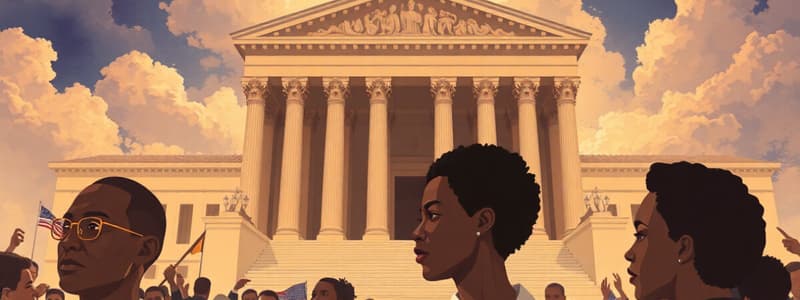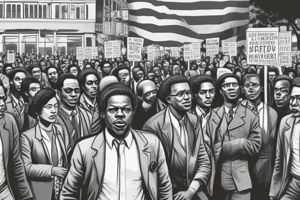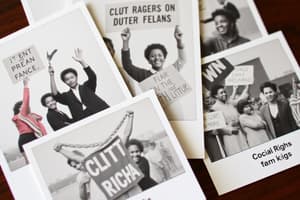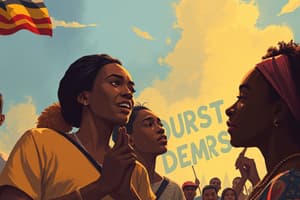Podcast
Questions and Answers
What was the primary focus of the NAACP upon its founding?
What was the primary focus of the NAACP upon its founding?
- Establishing economic independence for African Americans
- Advocating for women's rights
- Promoting educational opportunities for minorities
- Ending racial injustice (correct)
Which landmark case was overturned by the Supreme Court in Brown v. Board of Education?
Which landmark case was overturned by the Supreme Court in Brown v. Board of Education?
- *Gideon v. Wainwright*
- *Roe v. Wade*
- *Dred Scott v. Sandford*
- *Plessy v. Ferguson* (correct)
What legal strategy did the NAACP often employ in its cases against segregation?
What legal strategy did the NAACP often employ in its cases against segregation?
- Arguing under the 14th Amendment (correct)
- Using the Civil Rights Act of 1964
- Citing the First Amendment
- Challenging local ordinances
Which of the following figures was NOT mentioned as significant in the Civil Rights Movement according to the notes?
Which of the following figures was NOT mentioned as significant in the Civil Rights Movement according to the notes?
Which event is most closely associated with the beginning of the NAACP?
Which event is most closely associated with the beginning of the NAACP?
Flashcards
NAACP's Goal
NAACP's Goal
To end racial injustice through various means, focusing on legal and social actions.
Civil Rights Cases
Civil Rights Cases
Legal battles, protests, and important figures against racial inequality.
Landmark Supreme Court Cases
Landmark Supreme Court Cases
Landmark cases that dealt with school segregation, such as Plessy v. Ferguson and Brown v. Board of Education.
Legal Strategies (Civil Rights)
Legal Strategies (Civil Rights)
Signup and view all the flashcards
Key Civil Rights Figures
Key Civil Rights Figures
Signup and view all the flashcards
Study Notes
NAACP and Civil Rights
- Founded in 1909, currently active
- Worked to end racial inequality
- Provided legal representation
- Helped desegregate schools, for example, under Eisenhower and JFK
Plessy v. Ferguson
- 1896 Supreme Court case
- Upheld state-sponsored segregation
- Homer Plessy, challenged Louisiana segregation laws, was arrested
- The case was argued on how the segregation laws violated the 14th amendment of the U.S. Constitution.
- The Supreme Court ruled against Plessy
- "Separate but equal" doctrine established
Brown v. Board of Education
- 1954 Supreme Court case
- Overturned "separate but equal" doctrine
- Ended legally sanctioned segregation in public schools
- Earl Warren was the Chief Justice
- Significant change in racial integration
- Decision mandated the desegregation of schools as quickly as possible
Studying That Suits You
Use AI to generate personalized quizzes and flashcards to suit your learning preferences.




